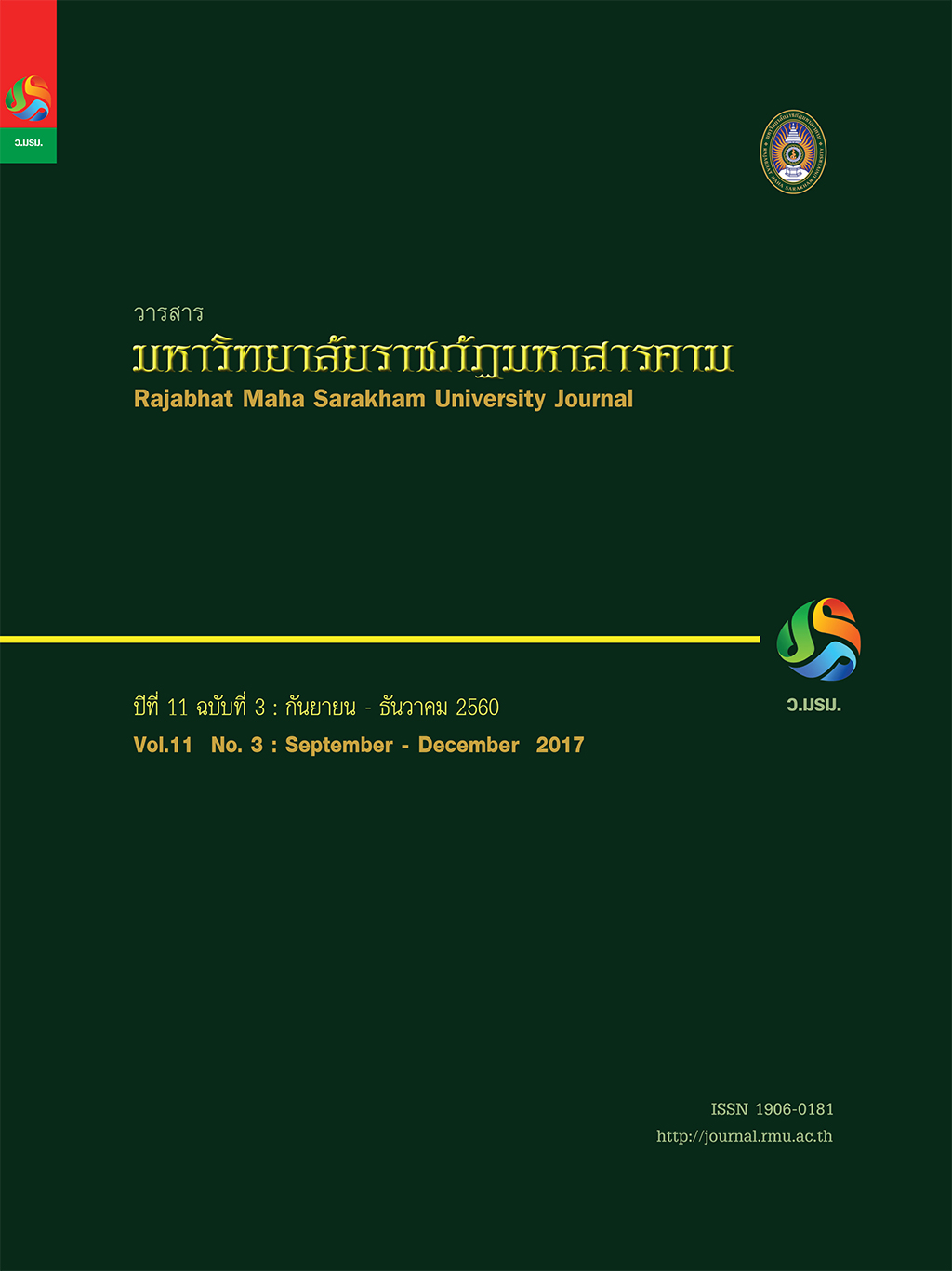การโต้แย้งทางวิทยาศาสตร์ของนักเรียนชั้นมัธยมศึกษาปีที่ 4 ในประเด็นทางสังคมที่เกี่ยวข้องกับวิทยาศาสตร์
Main Article Content
บทคัดย่อ
งานวิจัยนี้มีวัตถุประสงค์เพื่อศึกษาทักษะการโต้แย้งทางวิทยาศาสตร์ในประเด็นทางสังคมที่เกี่ยวข้องกับวิทยาศาสตร์ของนักเรียน
ชั้นมัธยมศึกษาปีที่ 4 โดยผู้วิจัยเก็บรวบรวมข้อมูลจากแบบวัดทักษะการโต้แย้งทางวิทยาศาสตร์ ที่เป็นคำถามปลายเปิดโดยใช้สถานการณ์
จำนวน 3 สถานการณ์ มีองค์ประกอบการโต้แย้ง 5 องค์ประกอบ คือ ข้อกล่าวอ้าง เหตุผลสนับสนุนข้อกล่าวอ้าง หลักฐานสนับสนุน
เหตุผล ข้อกล่าวอ้างที่ต่างออกไป และเหตุผลสนับสนุนการโต้แย้งกลับ โดยวิเคราะห์คำตอบของผู้เรียนแบบรายข้อ โดยอ่านคำตอบ
และการอธิบายเหตุผลในแต่ละประเด็นจากข้อคำถามย่อย จากนั้นตีความข้อความ โดยพิจารณาร่วมกับเกณฑ์การประเมินคุณภาพการ
โต้แย้ง ตามองค์ประกอบทักษะการโต้แย้ง ในการจัดระดับทักษะการโต้แย้ง คือ ระดับดีมาก ระดับดี ระดับพอใช้ และระดับปรับปรุง
มีการวิเคราะห์ข้อมูลโดยหาค่าความถี่ ร้อยละ และวิเคราะห์ข้อมูลเชิงเนื้อหา ผลการวิจัยพบว่าผู้เรียนมีทักษะการโต้แย้งทางวิทยาศาสตร์
โดยภาพรวมจากทุกสถานการณ์อยู่ในระดับพอใช้ และผู้เรียนส่วนใหญ่มีการแสดงข้อกล่าวอ้างและให้เหตุผลสนับสนุนข้อกล่าวอ้างใน
ระดับดี แตย่ งั ขาดทกั ษะในการหาหลักฐานเพือ่ สนับสนุนการใหเ้ หตผุ ลที่นา่ เชือ่ ถือ ทักษะการใหข้ อ้ กลา่ วอา้ งที่ตา่ งออกไป และใหเ้ หตุผล
สนับสนุนการโต้แย้งกลับ
Article Details
1. บทความที่ลงตีพิมพ์ทุกเรื่องได้รับการตรวจทางวิชาการโดยผู้ประเมินอิสระ ผู้ทรงคุณวุฒิ (Peer Review) สาขาที่เกี่ยวข้อง อย่างน้อย 3 ท่าน ในรูปแบบ Double blind review
2. ข้อคิดเห็นใด ๆ ของบทความที่ลงตีพิมพ์ในวารสารมหาวิทยาลัยราชภัฏมหาสารคาม นี้เป็นของผู้เขียน คณะผู้จัดทำวารสารไม่จำเป็นต้องเห็นด้วย
3. กองบรรณาธิการวารสารมหาวิทยาลัยราชภัฏมหาสารคาม ไม่สงวนสิทธิ์การคัดลอกแต่ให้อ้างอิงแสดงที่มา
เอกสารอ้างอิง
Young Students’ Collaborative Argumentation
Within a Socioscientific Issue”. Journal of Research
in Science Teaching. 50 : 209-237.
[2] Berland, L. K., and K. L. Mcneill. (2010). “A learning
progression for scientific argumentation :
Understanding student work and designing
supportive instructional contexts”. Science
Education. 94(5),765-793. DOI: 10.1002/sce.2040
[3] Iordanou, K., and Constantinou, C. P. (2015).
“Supporting use of evidence in argumentation
through practice in argumentation and reflection
in the context of SOCRATES learning
environment”. Science Education. 99. (2) : 282-311.
[4] Emig, B. R., and S. McDonald. (2014). “Inviting
argument by Analogy : Analogical-Mapping-Based
comparison activities as a scaffold for small-group
argumentation”. Science Education. 98, No.2,
PP.243-268.
[5] Yun, S.M and H. Baik Kim. (2015). Changes in
students’ participation and small group norms in
scientific argumentation. International Journal of
Science Education. 45: 465-484.
[6] Driver, R. et al. (2000). Establishing the Norms of
Scientific Argumentation inClassroom. Science
Education. 84 : 287-312.
[7] Sampson, V., J. Grooms and J. Walker. (2011).
“Argument-Driven inquiry as a way to help
students learn how to participate in scientific
argumentation and craft written arguments : An
exploratory study”, Science Education. 95(2),
217-257.
[8] Schwarz, B.B. (2009). Argumentation and Learning.
Argumentation and Education : Theoretical
Foundations and Practices.
[9] Lin, S.S., and J.J. Mintzes. (2010). “LearningArgu
mentation Skills Through Instrument In
Socioscientific Issues : The Effect of Ability
Level”, International Journal of Science and
Mathematics Education. 8 : 993-1017.
[10] Dawson, V.M., and G. Venville. (2010). “Teaching
strategies for developing students’ argumentation
skills about socioscientific issues in high school
genetics”, International Journal of Science
Education. 40 : 133-148.
[11] Anuworachai, Santichai. (2010). Effects of Biology
Instructionusing the Argument-Driven Inquiry
Instructional Model on Ability in Scientific Ex
planation Making and Rationlity of Upper
Secondary School Students. Master Thesis.
Department of Curriculum and Educational
Technology, Faculty of Education, Chulalongkorn
University.
[12] Newton, P., R. Driver and J. Osborne. (1999). “The
placeof argumentation in the pedagogy of
schoolscience”, International Journal of Science
Education. 21(5), 553-576.
[13] Bell, P. (2004). Promoting Students’ Argument
Construction and Collaborative Debate in the
Science Classroom. In M. Linn, E. Davis, & P. Bell
(Eds.), Internet environments forscience education
(pp. 115-143). New Jersey : Lawrence Erlbaum.
[14] Evagorou, M., M. Jimenez-Aleixandre and J.
Osborne. (2012).“Should We Kill the Grey Squirrels?
‘A Study Exploring Students’ Justifications and
Decision-Making”, International Journal of Science
Education. 34(3), 401-428.
[15] Sermsuk, Natthoo; Pitipornthephin, Sasithep;
Kowitwatee, Uthawan. (2015). The Development
of 10th Grade Students’ argumentation Skill in
the Topic of Life and Environment Using Socio
scientific Issues-Based Teaching. RSU National
Research Conference : page 1348-1355.
[16] Sandoval, W.D. and K.A. Millwood. (2005).
The quality of students’ use of evidence in
written scientific explanations. Cognition and
Instruction. 23 : 23-55.
[17] Levinson, R. (2006a). Teachers’ perceptions of the
role of evidence in teaching controversial
socioscientific issues. The Curriculum Journal,
17 : 247-262.
[18] Wu, Y.T and C.C. Tsai. (2007). “High school students’
informal reasoning on a socioscienctific issue:
Qualitative and quantitative analysis”,
International Journal of Science Education. 29 :
1163-1187.


